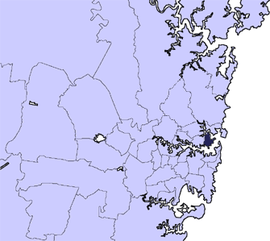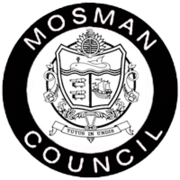Municipality of Mosman
| Mosman Council New South Wales | |||||||||||||
|---|---|---|---|---|---|---|---|---|---|---|---|---|---|
 Location in metropolitan Sydney | |||||||||||||
| Coordinates | 33°50′S 151°15′E / 33.833°S 151.250°ECoordinates: 33°50′S 151°15′E / 33.833°S 151.250°E | ||||||||||||
| Population | 30,496 (2015 est)[1] | ||||||||||||
| • Density | 3,388/km2 (8,770/sq mi) | ||||||||||||
| Area | 9 km2 (3.5 sq mi) | ||||||||||||
| Mayor | Peter Abelson (Serving Mosman) | ||||||||||||
| Council seat | Mosman | ||||||||||||
| Region | Metropolitan Sydney | ||||||||||||
| State electorate(s) | North Shore | ||||||||||||
| Federal Division(s) | Warringah | ||||||||||||
 | |||||||||||||
| Website | Mosman Council | ||||||||||||
| |||||||||||||
The Municipality of Mosman is a local government area on the Lower North Shore of Sydney, New South Wales, Australia.
The Mayor of the Mosman Council is Cr. Peter Abelson, a representative of the Serving Mosman independent political group.
A 2015 review of local government boundaries by the NSW Government Independent Pricing and Regulatory Tribunal recommended that the Municipality of Mosman merge with adjoining councils. The government considered two proposals. The first proposed a merger of Manly and Mosman Councils and parts of Warringah Council to form a new council with an area of 49 square kilometres (19 sq mi) and support a population of approximately 153,000.[2] The alternative, proposed by Warringah Council on 23 February 2016, was for an amalgamation of the Pittwater, Manly and Warringah councils. As a consequence of Warringah's proposal, the New South Wales Minister for Local Government Paul Toole proposed that the North Sydney, Willoughby and Mosman Council be merged.[3] The outcome of an independent review is expected by mid–2016.
Suburbs and localities in the local government area
In February 1997, the Government gazetted that they had assigned the suburb of Mosman as the only suburb in the Municipality of Mosman. However, Mosman Council decided that residents should continue to be allowed to use the traditional locality names if they wished.[4]
The municipality also includes, manages and maintains the following localities and locations:
- Athol Bay
- Balmoral
- Balmoral Beach
- Beauty Point
- Bradleys Head
- Chinamans Beach
- Chowder Bay
- Chowder Head
- Clifton Gardens
- Cobblers Beach
- Edwards Beach
- Georges Head
- Georges Heights
- Hunters Bay
- Little Sirius Cove
- Long Bay
- Middle Head
- Mosman Bay
- Obelisk Bay
- Parriwi Head
- Pearl Bay
- Quakers Hat Bay
- Rocky Point
- Shell Cove
- Spit Junction
- Taylors Bay
- Taronga Zoo
- The Spit
- Wyargine Point
Demographics
At the 2011 Census, there were 27,453 people in the Mosman local government area, of these 46.7% were male and 53.3% were female. Aboriginal and Torres Strait Islander people made up 0.1% of the population. The median age of people in the Municipality of Mosman was 36 years. Children aged 0 – 14 years made up 18.3% of the population and people aged 65 years and over made up 16.7% of the population. Of people in the area aged 15 years and over, 51.4% were married and 10.7% were either divorced or separated.[5]
Population growth in the Municipality of Mosman between the 2001 Census and the 2006 Census was 2.99%; and in the subsequent five years to the 2011 Census, population growth was 4.64%. When compared with total population growth of Australia for the same periods, being 5.78% and 8.32% respectively, population growth in the Mosman local government area was lower than the national average.[6] The median weekly income for residents within the Municipality of Mosman was significantly higher and nearly double the national average.[5][7]
In excess of 56.0% of residents in the Municipality of Mosman nominated an affiliation with Christianity at the 2011 Census, compared with the national average of 61.1%. The proportion of residents with no religion was on par with the national average. Compared to the national average, at the 2011 Census, households in the Mosman local government area had a low proportion (16.6%) where two or more languages are spoken (national average was 20.4%); and a high proportion (80.5%) where English only was spoken at home (national average was 76.8%).[5]
| Selected historical census data for Mosman local government area | |||||
|---|---|---|---|---|---|
| Census year | 2001[6] | 2006[7] | 2011[5] | ||
| Population | Estimated residents on Census night | 25,475 | 26,236 | 27,453 | |
| LGA rank in terms of size within New South Wales | 70 | ||||
| % of New South Wales population | 0.42% | 0.40% | |||
| % of Australian population | 0.14% | ||||
| Cultural and language diversity | |||||
| Ancestry, top responses | English | 29.0% | |||
| Australian | 20.6% | ||||
| Irish | 9.9% | ||||
| Scottish | 8.3% | ||||
| German | 2.9% | ||||
| Language, top responses (other than English) | Italian | 0.8% | |||
| German | 0.7% | ||||
| French | 0.7% | ||||
| Cantonese | 1.0% | ||||
| Mandarin | n/c | n/c | |||
| Religious affiliation | |||||
| Religious affiliation, top responses | Catholic | 25.3% | |||
| Anglican | 29.6% | ||||
| No religion | 17.1% | ||||
| Presbyterian and Reformed | 4.4% | ||||
| Uniting Church | 3.9% | ||||
| Median weekly incomes | |||||
| Personal income | Median weekly personal income | A$969 | A$1,117 | ||
| % of Australian median income | 207.9% | 193.6% | |||
| Family income | Median weekly family income | A$1,916 | A$2,838 | ||
| % of Australian median income | 186.6% | 191.6% | |||
| Household income | Median weekly household income | A$2,675 | A$2,465 | ||
| % of Australian median income | 228.4% | 199.8% | |||
Council
Current composition and election method
Mosman Municipal Council is composed of seven Councillors, including the Mayor, for a fixed four-year term of office. The Mayor is directly elected while the six other Councillors are elected proportionally as one ward. The most recent election was held on 8 September 2012, and the makeup of the Council, including the Mayor, is as follows:[8][9]
| Party | Councillors | |
|---|---|---|
| Serving Mosman | 3 | |
| Independent | 3 | |
| Residents for Mosman | 1 | |
| Total | 7 | |
The current Council, elected in 2012, in order of election, is:[8]
| Councillor | Party | Notes | |
|---|---|---|---|
| Peter Abelson | Serving Mosman | Mayor[9] | |
| Tom Sherlock | Serving Mosman | ||
| Roy Bendall | Residents for Mosman | Deputy Mayor | |
| Simon Menzies | Independent | ||
| Carolyn Corrigan | Serving Mosman | ||
| Libby Moline | Independent | ||
| Peter White | Independent | ||
Prior to the 2012 elections, the area was divided into three wards, each electing three councillors.[10]
Sister city
Mosman has twin town status with Glen Innes, New South Wales.
References
- ↑ "3218.0 – Regional Population Growth, Australia, 2014–15". Australian Bureau of Statistics. Retrieved 29 September 2016.
- ↑ "Merger proposal: Manly Council, Mosman Municipal Council, Warringah Council (part)" (PDF). Government of New South Wales. January 2016. p. 8. Retrieved 27 February 2016.
- ↑ Toole, Paul (25 February 2016). "North Sydney, Willoughby and Mosman councils Proposal" (PDF). Government of New South Wales. Retrieved 27 February 2016.
- ↑ "Ordinary Meeting Agenda" (PDF). Mosman Municipal Council. 29 November 2005. p. 83.
- 1 2 3 4 Australian Bureau of Statistics (31 October 2012). "Mosman (A)". 2011 Census QuickStats. Retrieved 5 November 2012.
- 1 2 Australian Bureau of Statistics (9 March 2006). "Mosman (A)". 2001 Census QuickStats. Retrieved 5 November 2012.
- 1 2 Australian Bureau of Statistics (25 October 2007). "Mosman (A)". 2006 Census QuickStats. Retrieved 5 November 2012.
- 1 2 "Mosman Municipal Council: Summary of First Preference and Group Votes for each Candidate". Local Government Elections 2012. Electoral Commission of New South Wales. 14 September 2012. Retrieved 19 September 2012.
- 1 2 "Mosman Municipal Council - Mayoral Election". Local Government Elections 2012. Electoral Commission of New South Wales. 13 September 2012. Retrieved 19 September 2012.
- ↑ "Mosman Municipal Council". 2008 Election results. Electoral Commission of New South Wales. Retrieved 17 September 2012.
External links
- Mosman Council website
- Community Profile of the Mosman Local Government Area
- Community Atlas of the Mosman Local Government Area
